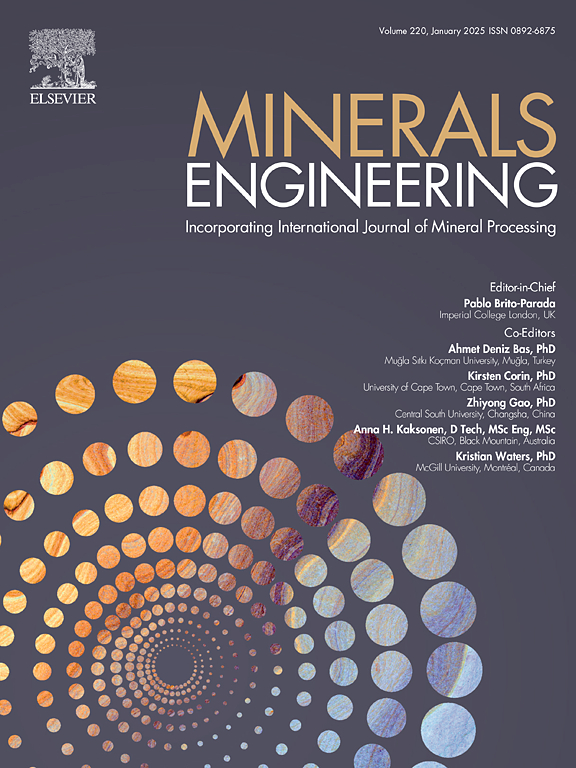New insights into the structure-activity relationship of the N containing heterocyclic activators for the lime depressed molybdenite flotation
IF 4.9
2区 工程技术
Q1 ENGINEERING, CHEMICAL
引用次数: 0
Abstract
The molybdenite is a typical layered sulfide mineral with extremely high natural hydrophobicity and therefore it is extracted by flotation technology. However, molybdenite is usually depressed by the flotation regulator lime and needs activization. In this study, we introduced 10 kinds of N-heterocycles to systematically study the structure–activity relationship of the N-heterocyclic flotation activators for the lime inhibited molybdenite, mainly through flotation tests, surface detection and DFT calculation. The flotation results showed that the lime almost irreversibly depressed the molybdenite flotation when using kerosene as collector alone, and adding these N-heterocyclic reagents effectively helped molybdenite regain its high flotability. When lime was used as 120 mg/L and kerosene at 30 mg/L, the activator effect could be ranked as: 3MI ≈ 2Phl ≈ 5 MB ≈ 5MI ≈ TTA > IND ≈ BTA ≈ Bzlm ≈ 5PhTH > 2MZ, which was decided by the recovery increment. The surface detection indicated that the depression mechanism of the lime was mainly through the adsorption of the CaOH+, Ca2+, Ca(OH)2 on the basal plane of molybdenite crystal, thus the chelating affinity of the N-heterocyclic reagents towards the lime components decided its activation ability. The DFT calculation suggested that the N-heterocycles was also able to interact with the Mo sites exposed by surface oxidation on the basal plane, thus the reactivity towards the Mo as well as the steric configuration also determined the activator effect. Therefore, the chelating ability of the activator towards the lime components/exposed Mo sites and the steric configuration of the rest alkyl group both contribute to the structure–activity relationship.

含N杂环活化剂在石灰抑制辉钼矿浮选中的构效关系新认识
辉钼矿是一种典型的层状硫化物矿物,具有极高的天然疏水性,故采用浮选技术提取。然而,辉钼矿通常被浮选调节剂石灰抑制,需要活化。本研究主要通过浮选试验、表面检测和DFT计算,引入10种n -杂环,系统研究了n -杂环型石灰抑制辉钼矿浮选活剂的构效关系。浮选结果表明,单独使用煤油作为捕收剂时,石灰几乎不可逆地抑制了辉钼矿的浮选,添加这些n -杂环药剂有效地恢复了辉钼矿的高可浮性。当石灰用量为120 mg/L,煤油用量为30 mg/L时,活化剂效果为:3MI≈2Phl≈5mb≈5MI≈TTA >;IND≈BTA≈Bzlm≈5PhTH >;2MZ,由恢复增量决定。表面检测表明,石灰的抑制机制主要是通过在辉钼矿晶体基面上吸附CaOH+、Ca2+、Ca(OH)2,因此n -杂环试剂对石灰组分的螯合亲和力决定了其活化能力。DFT计算表明,n -杂环也能与基底面表面氧化暴露的Mo位相互作用,因此对Mo的反应性和空间构型也决定了活化剂的作用。因此,活化剂对石灰组分/暴露的Mo位点的螯合能力和其余烷基的立体构型都有助于形成构效关系。
本文章由计算机程序翻译,如有差异,请以英文原文为准。
求助全文
约1分钟内获得全文
求助全文
来源期刊

Minerals Engineering
工程技术-工程:化工
CiteScore
8.70
自引率
18.80%
发文量
519
审稿时长
81 days
期刊介绍:
The purpose of the journal is to provide for the rapid publication of topical papers featuring the latest developments in the allied fields of mineral processing and extractive metallurgy. Its wide ranging coverage of research and practical (operating) topics includes physical separation methods, such as comminution, flotation concentration and dewatering, chemical methods such as bio-, hydro-, and electro-metallurgy, analytical techniques, process control, simulation and instrumentation, and mineralogical aspects of processing. Environmental issues, particularly those pertaining to sustainable development, will also be strongly covered.
 求助内容:
求助内容: 应助结果提醒方式:
应助结果提醒方式:


